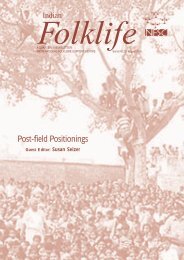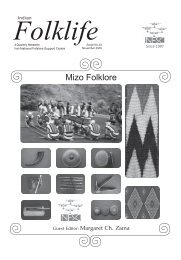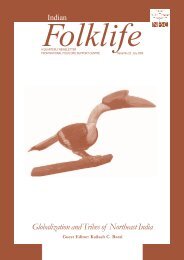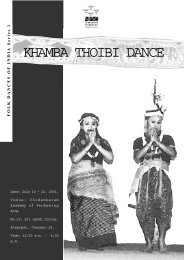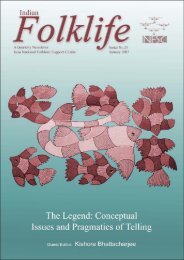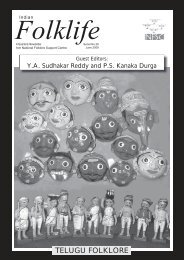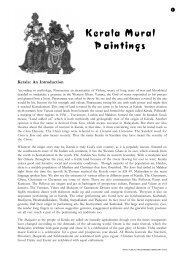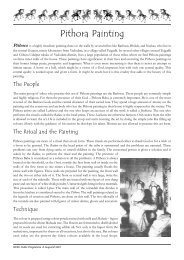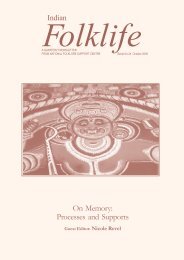Bamboo Flowering in the North-East - Wiki - National Folklore ...
Bamboo Flowering in the North-East - Wiki - National Folklore ...
Bamboo Flowering in the North-East - Wiki - National Folklore ...
Create successful ePaper yourself
Turn your PDF publications into a flip-book with our unique Google optimized e-Paper software.
are primarily responsible for <strong>the</strong> calamity. At last, <strong>the</strong>gods apologise and appeal to Kansari to save <strong>the</strong> world.Kansari br<strong>in</strong>gs <strong>the</strong> food and water back <strong>in</strong>to <strong>the</strong> world,<strong>the</strong>n br<strong>in</strong>gs her consort back to life, blesses her ardentfollower, <strong>the</strong> Kunbi, and at last takes her place of reverence<strong>in</strong> <strong>the</strong> conglomeration of <strong>the</strong> gods - <strong>the</strong> Devasabha.Although o<strong>the</strong>r versions of <strong>the</strong> Kansari story differ fromthis version almost <strong>in</strong> every literary respect, <strong>the</strong>re aresome common patterns of structure, behaviour andstatement implicit <strong>in</strong> <strong>the</strong>m are shared by all <strong>the</strong> versions.The first and foremost th<strong>in</strong>g that one notices <strong>in</strong> <strong>the</strong>sestories is a k<strong>in</strong>d of social hierarchy implied <strong>the</strong>re. Among<strong>the</strong> characters depicted, several are ‘gods’. They have acommunity of <strong>the</strong>ir own. There are also some ‘k<strong>in</strong>gs’.As aga<strong>in</strong>st <strong>the</strong>se powerful entities, <strong>the</strong>re are <strong>the</strong> ‘men’,The protagonist is supported <strong>in</strong> this fight by naturalelements such as clouds, w<strong>in</strong>d, thunderstorm, and <strong>the</strong>animals and birds befriended by him. They are peers of<strong>the</strong> protagonist, not slaves or servants to his command.With <strong>the</strong> help of <strong>the</strong>se friends from <strong>the</strong> natural world,<strong>the</strong> cultivator protagonist defies <strong>the</strong> powerful lords andestablishes his supremacy <strong>in</strong> cultivation and hisunchallengeable relationship with foodgra<strong>in</strong>, with <strong>the</strong>goddess Kansari promis<strong>in</strong>g <strong>the</strong> Kunbi, “I will always staywith you. I will give you prosperity. Toil <strong>in</strong> <strong>the</strong> soil; holdalways a stick <strong>in</strong> your hand. Feed <strong>the</strong> hungry. I’ll be withyou.”There is ano<strong>the</strong>r <strong>in</strong>terest<strong>in</strong>g character-motif <strong>in</strong> <strong>the</strong> stories.There is Yehu Mawli – Mo<strong>the</strong>r Yehu — who commandsall <strong>the</strong> seeds of foodgra<strong>in</strong>. In case of want of seeds, <strong>the</strong>Kunbi can assuredly go to Yehu and ask for seeds (onreturn basis). Yehu certa<strong>in</strong>ly is not a memberof <strong>the</strong> Devsabha, yet she commandsrecognition among <strong>the</strong> gods; <strong>the</strong> Kunbisrevere her and depend on her. In one of <strong>the</strong>stories, Yehu is depicted as an old woman(doshi), with eyes as big as <strong>the</strong> wheel of acart, one requir<strong>in</strong>g space of twelve bullocksfor her seat and one call<strong>in</strong>g with a robustshout. In ano<strong>the</strong>r story, Yehu is an asceticmaid, who conceives by ‘consum<strong>in</strong>g <strong>the</strong>bread half consumed by Mahadev.’ Kansariis born. Later, she f<strong>in</strong>ds out <strong>the</strong> whereaboutsof <strong>the</strong> irresponsible fa<strong>the</strong>r from Yehu andmanifests her powers to him.<strong>the</strong> ‘Dubla Kunbis’ (mean<strong>in</strong>g poor farmers, also specificcommunity names). The focal po<strong>in</strong>t of <strong>the</strong> story is always<strong>the</strong> equation and tension between <strong>the</strong>se two groups. Apartfrom <strong>the</strong> gods, <strong>the</strong>re is also a Bhagwan who seems to bea higher god with wider powers and who is beyond <strong>the</strong>tension between <strong>the</strong> two.Among <strong>the</strong> gods <strong>the</strong>re is a ‘Mahadev’. He is powerfulamong <strong>the</strong> gods, commands <strong>the</strong>ir community and he is<strong>the</strong> ‘lord’ for <strong>the</strong> ‘people’ <strong>in</strong> <strong>the</strong> respective story. He is<strong>the</strong> chief of ‘Dwaraka’ city, which is <strong>the</strong> seat of power of<strong>the</strong> gods. One can see a certa<strong>in</strong> acceptance of his place ofpower at <strong>the</strong> primary level; yet, when he, along with hisassociates turns atrociously aga<strong>in</strong>st <strong>the</strong> people out ofjealousy or greed, <strong>the</strong>re is revolt aga<strong>in</strong>st him by <strong>the</strong>protagonist, ei<strong>the</strong>r Kansari herself <strong>in</strong> a human form or<strong>the</strong> Kunbi, <strong>the</strong> cultivator of foodgra<strong>in</strong>, or sometimesKansari herself as <strong>the</strong> cultivator. It may be a mild fightonly to cleverly escape <strong>the</strong> atrocity or exploitation, or maytake <strong>the</strong> form of a clearly spelt out, explicit war <strong>in</strong>volv<strong>in</strong>g<strong>the</strong> phenomena and affect<strong>in</strong>g <strong>the</strong> entire humanity.Bhagat narrat<strong>in</strong>g <strong>the</strong> story of KansariKansari, as a character <strong>in</strong> <strong>the</strong> stories, is oftendepicted as a young girl. The girl hassuperhuman qualities suggest<strong>in</strong>g or lead<strong>in</strong>gto prosperity, yet she herself denies allpleasures and comforts and prefers to livea commoner’s life, toil<strong>in</strong>g <strong>in</strong> <strong>the</strong> soil. Kansariis an <strong>in</strong>dependent m<strong>in</strong>d, nobody can own or commandher. She lives where she wants to live, does what shewants to do; she values and ma<strong>in</strong>ta<strong>in</strong>s her dignity and<strong>in</strong>dependence. In several stories, she comes to <strong>the</strong> Kunbi’shouse as a diseased and dirty creature and tests hischaracter. While all o<strong>the</strong>rs despise her, Kunbi is k<strong>in</strong>d toher and offers her regular shelter and bread to be sharedwith him. Kansari is pleased with this nobility and blesseshim with prosperity. But when this prosperity leads to<strong>in</strong>dignant treatment to her, she immediately leaves him;all his prosperity vanishes and <strong>in</strong> repentance, he yieldsto her.As one looks at a number of <strong>the</strong>se stories toge<strong>the</strong>r, <strong>the</strong>rearise several questions <strong>in</strong> one’s m<strong>in</strong>d. First of all, should<strong>the</strong>se stories be grouped toge<strong>the</strong>r as a whole or should<strong>the</strong>y be treated as separate tales? All <strong>the</strong> stories are referredto by <strong>the</strong> community members as ‘<strong>the</strong> tale of Kansari’,yet <strong>the</strong>re is so much variation <strong>in</strong> every aspect that it ishard to relate any particular version to ano<strong>the</strong>r, sometimeseven <strong>the</strong> character of Kansari herself be<strong>in</strong>g a somewhat16 INDIAN FOLKLIFE VOLUME 2 ISSUE 3 JANUARY - MARCH 2003




